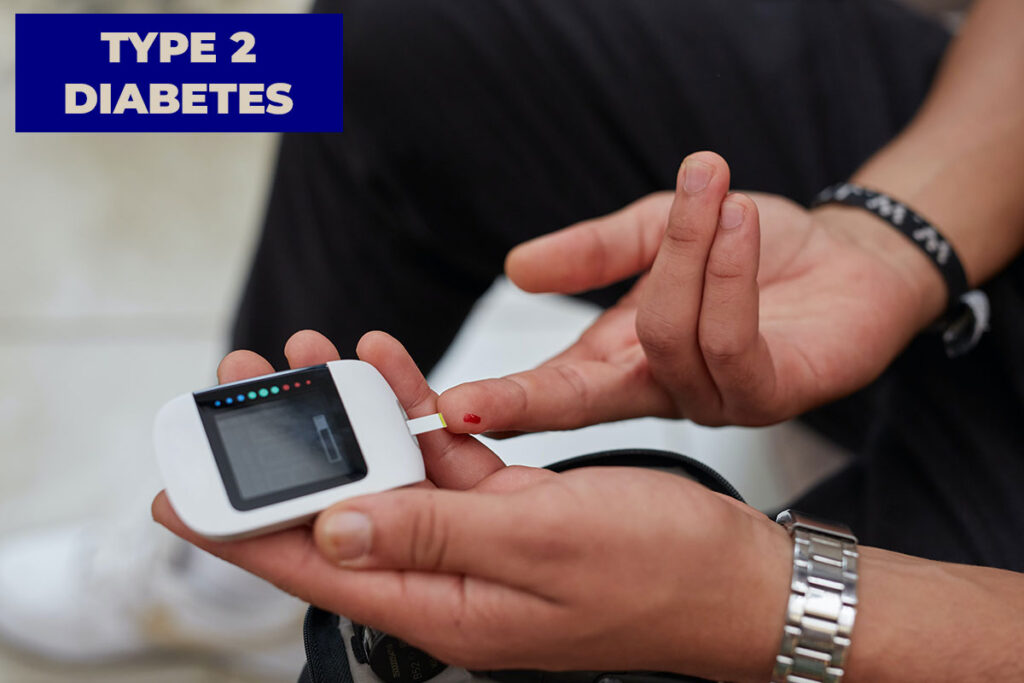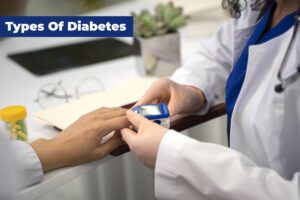
Type 2 Diabetes
Type 2 diabetes is a prevalent health condition that affects millions of people worldwide.
While type 2 diabetes primarily affects individuals aged 45 and older, there is a growing trend of children, teenagers, and young adults being diagnosed with the condition.
In this comprehensive guide, we will take a closer look at the intricacies of type 2 diabetes, exploring its causes, symptoms, management strategies, and lifestyle considerations.
If you’ve recently received a diagnosis or are looking for valuable insights for yourself or a loved one, this article aims to provide a well-rounded understanding of type 2 diabetes.
What is Type 2 Diabetes?
Type 2 diabetes is a type of diabetes that occurs when the body has trouble regulating and using sugar (glucose) as fuel. This chronic condition results in high levels of sugar in the blood.
Persistently high blood sugar levels can lead to complications affecting the circulatory, nervous, and immune systems.
This usually causes significant harm to the body and contributes to serious health complications, including heart disease, vision impairment, and kidney disease.
It is essential to manage blood sugar levels effectively to mitigate these risks and maintain overall well-being.
While type 2 diabetes was previously known as adult-onset diabetes, it can develop in both children and adults.
It is more prevalent in older adults, but the rise in childhood obesity has led to an increase in type 2 diabetes cases among young people.
What Causes Type 2 Diabetes?
The development of type 2 diabetes can be attributed to two main factors: insulin resistance and insufficient insulin production.
Insulin resistance occurs when cells in the muscles, fat, and liver display reduced responsiveness to insulin, resulting in diminished absorption of sugar.
Insufficient insulin production occurs when the pancreas, the hormone responsible for facilitating the entry of sugar into cells, fails to generate an adequate amount of insulin to effectively regulate blood sugar levels.
To elaborate, insulin, a hormone produced by the pancreas, plays a crucial role in enabling cells to utilize blood sugar for energy.
However, individuals with type 2 diabetes experience an inadequate response to insulin, a condition known as insulin resistance.
Consequently, the pancreas compensates by increasing insulin production in an attempt to stimulate cell responses.
Over time, the pancreas becomes unable to sustain this heightened insulin production, leading to elevated blood sugar levels and the progression from prediabetes to type 2 diabetes.
The precise underlying causes of these issues are not fully understood.
However, genetics, lifestyle factors, obesity, and sedentary habits are significant factors associated with the development of type 2 diabetes.
By understanding these factors, individuals can make informed choices to reduce their risk and promote their overall well-being.
Symptoms of Type 2 Diabetes
The symptoms of type 2 diabetes often develop slowly, and it is possible to live with the condition for an extended period without being aware of it.
Therefore, it is important to be mindful of the risk factors associated with type 2 diabetes.
Recognizing the symptoms is critical for early intervention.
If you have any of the risk factors, it is recommended that you consult your doctor and undergo blood sugar testing for a proper evaluation.
When symptoms of type 2 diabetes do appear, they commonly include the following:
Frequent urination: You may need to urinate more often than usual, including waking up multiple times during the night to use the bathroom.
Increased hunger: You may feel hungrier than usual, even after eating a meal.
Increased thirst: You may experience excessive thirst, even after drinking an adequate amount of fluids.
Fatigue: Feeling tired and lacking energy, even after getting sufficient rest, is a common symptom of type 2 diabetes.
Unintended weight loss: Despite not making any conscious efforts to lose weight, you may experience a gradual and unexplained decrease in body weight.
Slow-healing sores: Wounds, cuts, or sores may take longer to heal than usual.
Blurred vision: High blood sugar levels can cause changes in the lens of the eye, resulting in blurred or impaired vision.
Areas of darkened skin: Dark patches of skin, often found in the armpits and neck, may develop. This condition is called acanthosis nigricans and is associated with insulin resistance.
Frequent infections: Individuals with type 2 diabetes may be more susceptible to infections, such as urinary tract infections, skin infections, and yeast infections.
Numbness or tingling in the hands or feet: This sensation, known as peripheral neuropathy, can occur due to nerve damage caused by high blood sugar levels.
NOTE
If you experience any of these symptoms or have concerns about your health, it is crucial to consult a healthcare professional for proper evaluation, diagnosis, and treatment.
Early detection and management of type 2 diabetes are essential for maintaining overall health and preventing complications.
What Are the Risks of Developing Type 2 Diabetes?
Certain factors can contribute to an increased risk of developing type 2 diabetes. However, the risks of developing type 2 diabetes can vary depending on various factors. Here are some common risk factors associated with type 2 diabetes:
Weight and Fat Distribution
Weight plays a significant role in the development of type 2 diabetes.
Being overweight or obese increases the risk of insulin resistance, the key underlying factor in type 2 diabetes.
Excess body weight, particularly an accumulation of visceral fat (fat stored around the abdominal organs), disrupts the balance of hormones and metabolic processes in the body.
This disruption interferes with the normal functioning of insulin, leading to reduced insulin sensitivity in the cells.
As a result, the cells become less responsive to insulin, and the body struggles to regulate blood sugar levels effectively.
Storing excess fat in the abdominal region, as opposed to the hips and thighs, is associated with a higher risk of type 2 diabetes.
Men with a waist circumference above 40 inches (101.6 centimeters) and women with a waist measurement above 35 inches (88.9 centimeters) are at increased risk.
Prediabetes
Prediabetes is a condition characterized by blood sugar levels that are higher than normal but not yet in the range of diabetes.
It is an important intermediate stage between normal blood sugar levels and the diagnosis of type 2 diabetes.
Having prediabetes significantly increases the risk of developing type 2 diabetes if left untreated or unmanaged.
The presence of prediabetes indicates that the body is beginning to have difficulty regulating blood sugar levels effectively.
Without intervention, prediabetes can progress to type 2 diabetes over time.
However, it’s important to note that not all individuals with prediabetes will develop diabetes.
With appropriate lifestyle changes and management, it is possible to reverse prediabetes or prevent its progression to type 2 diabetes.
Leading a Sedentary Lifestyle
Leading a sedentary lifestyle significantly increases the risk of developing type 2 diabetes.
Inactivity, characterized by prolonged periods of sitting or low levels of physical activity, can have detrimental effects on overall health, including the body’s ability to regulate blood sugar levels effectively.
Regular physical activity plays a crucial role in the prevention and management of type 2 diabetes.
Age
Age is a significant risk factor for the development of type 2 diabetes.
The risk tends to increase with advancing age, particularly after the age of 35.
Understanding the relationship between age and type 2 diabetes is crucial for early detection, prevention, and appropriate management of the condition.
Several factors contribute to the increased risk of type 2 diabetes with age, which include reduced insulin sensitivity, changes in body composition, and hormonal changes.
Family History
Family history is a significant risk factor for type 2 diabetes. If a person has a parent or sibling with the condition, their own risk of developing type 2 diabetes is increased compared to those without a family history.
The influence of family history on type 2 diabetes risk suggests a combination of genetic and environmental factors at play.
Genetic factors can contribute to an individual’s susceptibility to developing insulin resistance or impaired insulin production, which are key factors in type 2 diabetes.
However, it’s important to note that having a family history of type 2 diabetes does not guarantee that an individual will develop the condition.
Race and Ethnicity
Race and ethnicity are important factors that influence the risk of developing type 2 diabetes.
Certain racial and ethnic groups, including black, Hispanic, Native American, Asian, and Pacific Islander populations, have a higher likelihood of developing the condition compared to white individuals.
However, it is important to note that these tendencies are generalizations, and individual risk can vary within these groups.
The reasons for the disparities in type 2 diabetes prevalence among different racial and ethnic groups are complex and not fully understood.
Several factors contribute to these differences, including genetic predisposition, cultural and socioeconomic factors, and variations in lifestyle and healthcare access.
Blood Lipid Levels
Blood lipid levels, specifically low levels of high-density lipoprotein (HDL) cholesterol and high levels of triglycerides, have been identified as risk factors for the development of type 2 diabetes.
Understanding these lipid abnormalities is important for assessing an individual’s risk and implementing appropriate preventive measures.
Pregnancy-Related Risks
Pregnancy-related factors can have a significant impact on a woman’s risk of developing type 2 diabetes later in life.
Two important factors that increase the risk are gestational diabetes and giving birth to a baby weighing more than 9 pounds (4 kilograms).
Gestational diabetes is a form of diabetes that occurs during pregnancy and typically resolves after childbirth.
However, women who have had gestational diabetes are at a higher risk of developing type 2 diabetes later in life.
This is because gestational diabetes is an indication of impaired glucose metabolism and insulin resistance, both of which are significant factors in the development of type 2 diabetes.
Understanding these risks is crucial for postpartum monitoring, preventive measures, and long-term health management.
Polycystic Ovary Syndrome (PCOS)
Polycystic ovary syndrome (PCOS) is a hormonal disorder that affects many women of reproductive age.
In addition to its impact on fertility and reproductive health, PCOS is also associated with an increased risk of developing type 2 diabetes.
PCOS is characterized by a combination of symptoms, which can vary in severity among individuals.
These symptoms may include irregular menstrual periods, excess hair growth (hirsutism), acne, and obesity.
The underlying hormonal imbalances in PCOS, such as high levels of insulin and androgens (male hormones), contribute to the increased risk of developing diabetes.
Understanding the relationship between PCOS and diabetes is important for early detection, management, and preventive measures.
How to Prevent Type 2 Diabetes
Making healthy lifestyle choices is key to preventing type 2 diabetes.
In the case of a prediabetes diagnosis, implementing lifestyle changes can help slow down or even halt the progression to diabetes.
Here are some important aspects of a healthy lifestyle:
Healthy Eating
Opt for foods that are low in fat and calories while being rich in fiber. Focus on incorporating fruits, vegetables, and whole grains into your diet.
Regular Physical Activity
Aim for at least 150 minutes of moderate-to-vigorous aerobic activity per week. This can include activities like brisk walking, cycling, running, or swimming.
Weight Management
If you are overweight, even losing a modest amount of weight and maintaining it can significantly delay the progression from prediabetes to type 2 diabetes.
For individuals with prediabetes, shedding 7% to 10% of their body weight can help reduce the risk of developing diabetes.
Avoiding Prolonged Inactivity
Long periods of sitting or physical inactivity can increase the risk of type 2 diabetes. It is important to take breaks every 30 minutes and engage in light movement for a few minutes.
Medication
In some cases, for individuals with prediabetes who are at higher risk, healthcare professionals may prescribe metformin (Fortamet, Glumetza, and others), a diabetes medication.
Metformin can help reduce the risk of developing type 2 diabetes, especially for older adults who are obese and are unable to effectively lower their blood sugar levels through lifestyle changes alone.
Remember, prevention is always better than treatment.
By adopting a healthy lifestyle, you can significantly reduce your risk of developing type 2 diabetes and enjoy improved overall well-being.
However, it is important to consult with healthcare professionals for personalized guidance and support in your prevention journey.
What are the Cure for Type 2 Diabetes?
Unfortunately, there is no cure for type 2 diabetes. However, managing the condition is possible through weight loss, a healthy diet, and regular exercise.
If lifestyle changes are insufficient for controlling blood sugar levels, diabetes medications or insulin therapy may be recommended.
Persistently high blood sugar levels can cause significant harm to the body and contribute to serious health complications, including heart disease, vision impairment, and kidney disease.
It is essential to manage blood sugar levels effectively to mitigate these risks and maintain overall well-being.
How to Manage Diabetes
Managing type 2 diabetes involves a multifaceted approach, with lifestyle modifications playing a key role.
It requires active participation on the individual’s part, with the support of their healthcare team, family, and other important individuals in their life.
While it can be challenging, all the effort patients make to improve their health is immensely valuable.
Depending on each person’s specific situation, they may be able to manage their diabetes through healthy eating and regular physical activity.
Alternatively, their doctor may prescribe insulin, other injectable medications, or oral diabetes medicines to help control their blood sugar levels and prevent complications.
Even if medication is necessary, maintaining a healthy diet and staying physically active remain important.
Additionally, it is crucial to manage blood pressure and cholesterol levels within the targets set by their doctor and undergo necessary screening tests.
Regular monitoring of blood sugar levels is essential. Individuals should consult their doctor regarding the frequency of blood sugar checks and the target levels they should aim for.
Keeping blood sugar levels as close to the target range as possible will significantly reduce the risk of diabetes-related complications.
Stress is a part of life, but it can make managing diabetes more challenging, affecting blood sugar levels and daily diabetes care.
Engaging in regular physical activity, ensuring sufficient sleep, and practicing relaxation exercises can help alleviate stress.
It is also important to discuss additional stress management strategies with their doctor and diabetes educator.
Scheduling regular appointments with the healthcare team is important to ensure effective adherence to the treatment plan.
These appointments provide an opportunity to seek guidance, discuss new ideas, and develop strategies to overcome any challenges encountered along the way.
Final Note
Type 2 diabetes is a chronic condition characterized by insulin resistance, which results in reduced responsiveness of the body’s cells to insulin.
This leads to elevated levels of blood sugar, affecting various aspects of health.
However, it is important to note that type 2 diabetes is a manageable condition that requires a proactive and informed approach.
Diagnostic tools such as blood tests can confirm the presence of elevated blood sugar levels.
A timely diagnosis allows for prompt management, minimizing the risk of complications.
By comprehending the underlying causes, recognizing symptoms, adopting healthy lifestyle practices, and collaborating closely with healthcare professionals, individuals can effectively navigate the challenges associated with type 2 diabetes.
We hope this guide has provided readers with the necessary knowledge and resources to better understand type 2 diabetes and the circumstances surrounding it.
DISCLAIMER:
The information provided in this article is intended for general informational purposes only and does not take into account your specific circumstances. It should not be considered a substitute for professional medical assistance or advice. You should not rely solely on the information presented in this article when making decisions. Any actions taken based on the information in this article are done so at your own risk and responsibility.







